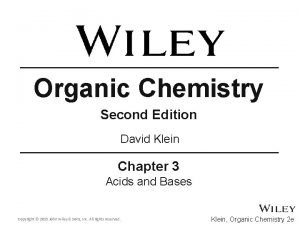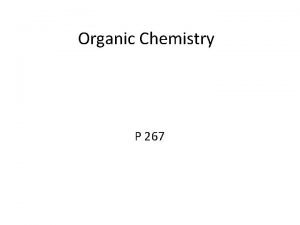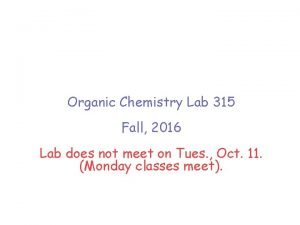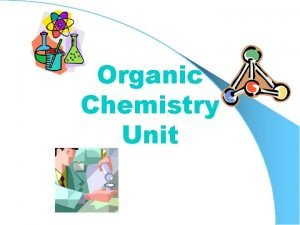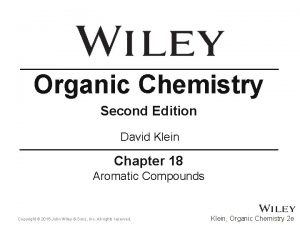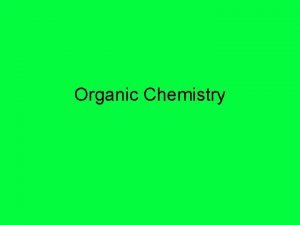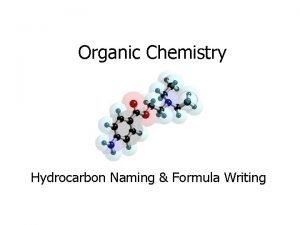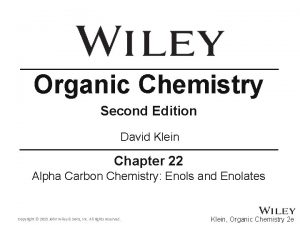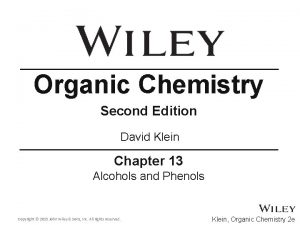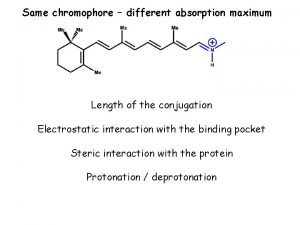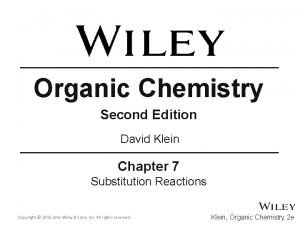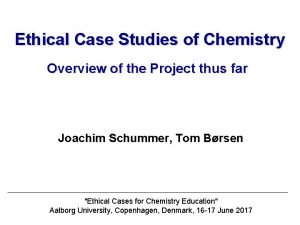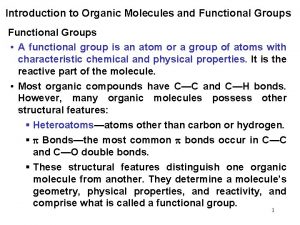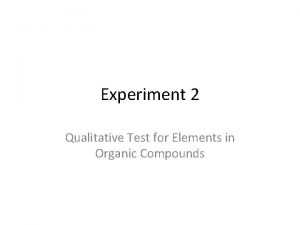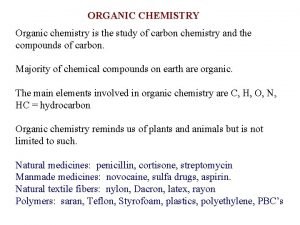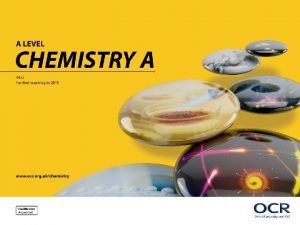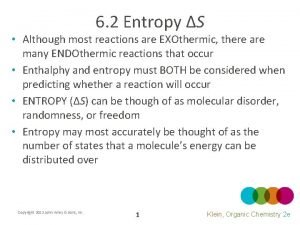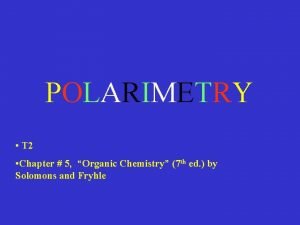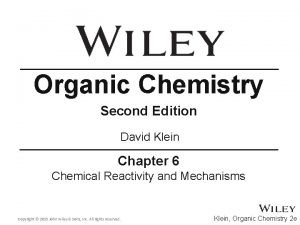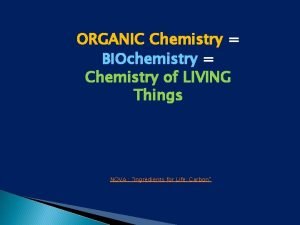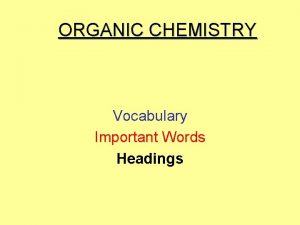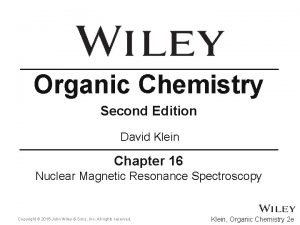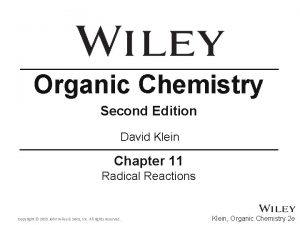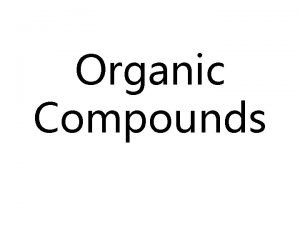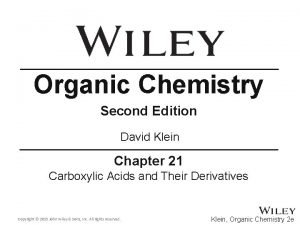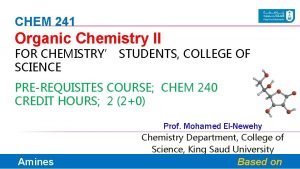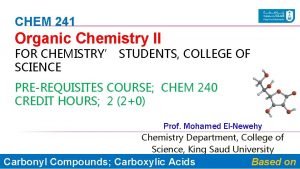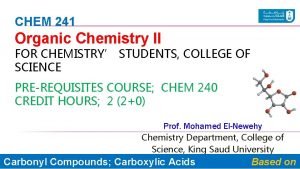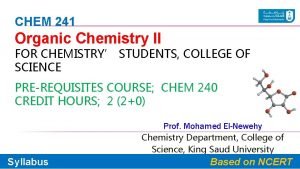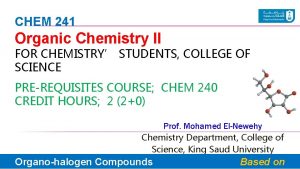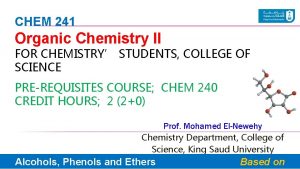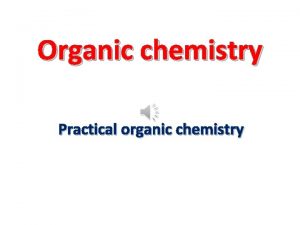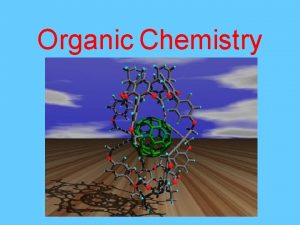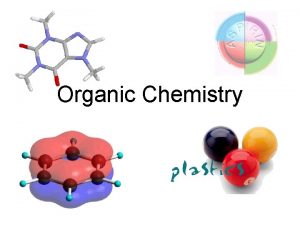CHEM 241 Organic Chemistry II FOR CHEMISTRY STUDENTS




















































- Slides: 52

CHEM 241 Organic Chemistry II FOR CHEMISTRY’ STUDENTS, COLLEGE OF SCIENCE PRE-REQUISITES COURSE; CHEM 240 CREDIT HOURS; 2 (2+0) Prof. Mohamed El-Newehy Chemistry Department, College of Science, King Saud University Alcohols, Phenols and Ethers http: //fac. ksu. edu. sa/melnewehy/home Based on 1

Alcohols, Phenols and Ethers Ø Alcohols, phenols and ethers may be viewed as organic derivatives of water. H-O- R-O-H Ar-O- R-O-R R-O-Ar Ar. H Alcoh H O-Ar Water ol Pheno Ether Ø Alcohols and phenols have a common lfunctional group, the hydroxyl group, -OH. Ø An alcohol contains one or more hydroxyl (OH) group(s) directly attached to carbon atom(s), of an aliphatic system (CH 3 OH). Ø A phenol contains –OH group(s) directly attached to carbon atom(s) of an aromatic system (C 6 H 5 OH). Ø Ethers; the substitution of a hydrogen atom in a hydrocarbon by an alkoxy or aryloxy group the (R–O/Ar–O) (CHof substitution a hydrogen atom of hydroxyl group of an alcohol or phenol by 3 OCH 3). an alkyl or aryl group.

Classification of Alcohols and Phenols Ø Alcohols and phenols may be classified as mono–, di–, tri- or polyhydric compounds depending on whether they contain one, two, three or many hydroxyl groups, respectively.

Classification of Alcohols and Phenols Ø Monohydric alcohols are classified according to the hybridization of the carbon atom to which the hydroxyl group is attached. (i) Compounds containing Csp 3 -OH bond: the –OH group is attached to an sp 3 hybridized carbon atom of an alkyl group. § Primary, secondary and tertiary alcohols: the –OH group is attached to primary, secondary and tertiary carbon atom, respectively. § Allylic alcohols: the —OH group is attached to a sp 3 hybridized carbon next to the carbon double bond. § Benzylic alcohols: In these alcohols, the —OH group is attached to a sp 3 -hybridized carbon atom next to an aromatic ring.

Classification of Alcohols and (ii) Compounds Phenols containing Csp 2 -OH bond: these alcohols contain —OH group bonded to a carbon-carbon double bond. § vinylic alcohols: —OH group bonded to a vinylic carbon. § Phenols: —OH group bonded to an aryl carbon. Classification of Ethers Ø Ethers are classified: o Simple or symmetrical ethers, if the alkyl or aryl groups attached to the oxygen atom are the same. Example: Diethyl ether, C H 5 OC 2 H 5. o Mixed or unsymmetrical 2 ethers, if the alkyl or aryl groups attached to the oxygen atom different. Example: C 2 H 5 OCH 3 and C 2 H 5 OC 6 H 5.

o Nomenclature of Alcohols The common name of an alcohol is derived from the common name of the alkyl group and adding the word alcohol to it. Alkyl Example: CH 3 OH is methyl alcohol o In the IUPAC system, alcohols are named according to the following rules. 1. Select the longest continuous carbon chain that contains the -OH group. Drop the –e ending of the parent alkane and replace it by the suffix -ol: Alkane – e + ol = Alkanol 2. When isomers are possible, the chain is numbered so as to give the functional group (-OH) the lowest possible number.

Nomenclature of Alcohols 3. When alkyl side chains or other groups are present; they are named alphabetically and their positions are indicated by a number. The position of the functional group (-OH) is always given the lowest possible number at the end of the name. 4. With Unsaturated Alcohols; If a molecule contains both an -OH group and a C=C or C-C triple bond, the -OH group takes preference before the double or triple bonds in getting the lower number. The name should include (if possible) both the hydroxyl and the unsaturated groups, even if this does not make the longest chain the parent hydrocarbon.

Nomenclature of o Cyclic. Alcohols are named using the prefix cyclo and considering the —OH group attached to C– 1. o For naming polyhydric alcohols, the ‘e’ of alkane is retained and the ending ‘ol’ is added. § The number of –OH groups is indicated by adding the multiplicative prefix, di, tri, before ‘ol’. § etc. , The positions of –OH groups are indicated by appropriate locantions e. g. , HO–CH 2–OH is named as ethane– 1, 2 -diol. § Compounds with two adjacent alcohol groups are called glycols.

o Nomenclature of Phenols The simplest hydroxy derivative of benzene is phenol and its common name and also an accepted IUPAC name. o Dihydroxy derivatives of benzene are known as 1, 2 -, 1, 3 - and 1, 4 benzenediol. o The hydroxyl group is named as a substituent when it occurs in the same molecule with carboxylic acid, aldehyde, or ketone functionalities, which have priority in naming.

Nomenclature of Ethers o Common names of ethers are derived from the names of alkyl/aryl groups written as separate words in alphabetical order and adding the word ‘ether’ at the end. alkyl/aryl ether o If both the alkyl groups are the same, the prefix ‘di’ is added before the alkyl group. o IUPAC system, ethers are regarded as hydrocarbon derivatives in which a hydrogen atom is replaced by; • an alkoxy group (–OR) or aryloxy group (–Oar), where R and Ar represent alkyl and aryl groups, o The larger (R) group is chosen as respectively. the parent hydrocarbon.

Hydrogen Bonding in Alcohols, Phenols and Ethers o The O-H bond is polarized by the high electronegativity of the oxygen atom and places a partial positive charge on the hydrogen atom and a partial negative charge on the oxygen atom. o Two or more alcohol molecules thus become loosely bonded to one another through hydrogen bonds. o Hydrogen bonds are weaker than ordinary covalent bonds. o Ether molecules cannot form hydrogen bonds with one another, as their structures has no O-H bonds. o The lower molecular-weight alcohols and ethers can form H-bond with water molecules.

Physical Properties of Alcohols, Phenols and Ethers o Physical State • The simplest alcohol, methanol, is a liquid at room temperature. In contrast, alkanes from methane to butane are gases. • Phenol is a colorless, crystalline, and low-melting solid and other phenols also are solids. are colorless compounds with characteristic, relatively pleasant odors. • Ethers o Boiling • Points Ethers have lower boiling points (bp, s) than alcohols with an equal number of atoms. • carbon Ether has nearly the same b. p. as the corresponding hydrocarbon in which a -CH 2 - group replaces ether’s oxygen. Because the of their structures (no O-H bonds), ether molecules cannot form hydrogen bonds with one another.

Physical Properties of Alcohols, Phenols and Ethers o Boiling Points • Series of normal alcohols; the boiling points increase with increasing molecular • weights. A comparison of boiling points among isomeric alcohols; The boiling points decrease as the number of alkyl branches from the carbinol group increases.

Physical Properties of Alcohols, Phenols and Ethers o Solubili • ty. The lower alcohols are completely miscible with water. • As the number of carbons in the alcohol increases, the solubility in water decreases. • Low-molecular-weight ethers, such as dimethyl ether, are quite soluble in water. Ether molecules can form hydrogen bonds to water. • Phenol and most other phenols are slightly soluble in water.

Importance of Alcohols, Phenols Ø Alcohols, phenols andand ethers Ethers are the basic compounds for the formation of detergents, antiseptics and fragrances, respectively. Ø These classes of compounds find wide applications in industry as well as in day-to-day life. o The sugar we eat, the cotton used for fabrics, the paper we use for writing, are all made up of compounds containing –OH groups. o Ethanol is used as a solvent in paint industry and in the preparation of a number of carbon compounds. o The commercial alcohol is made unfit for drinking by mixing in it some copper sulphate (to give it a color) and pyridine (a foul smelling liquid). o acts the central nervous system. o Ingestion Methanolof is ethanol poisonous in on nature. Ingestion of even small quantities of methanol can cause blindness and large quantities causes even death. o Methanol is used as a solvent in paints, varnishes and chiefly for making formaldehyde. o Ethylene glycol is used as the “permanent” antifreeze in automobile radiators and as a raw material in the manufacture of Dacron. o Ethylene glycol is completely miscible with water. o Glycerol is a syrupy, colorless, water-soluble, high-boiling liquid with a distinctly sweet taste. Its soothing qualities make it useful in shaving and toilet soaps and in cough drops and syrups.

Importance of Alcohols, Phenols Occurrence and uses of phenols Ethers an antiseptic disinfectants antioxidants

Preparation of From Alcohols Alkenes (i) Hydration of Alkenes: alkenes react with water in the presence of acid as catalyst to form alcohols. o In case of unsymmetrical alkenes, the addition reaction takes place in accordance with Markovnikov’s rule. o It is not possible to prepare primary alcohols except Ethanol.

Preparation of From Alcohols Alkenes Hydration of Alkenes; Mechanism: three steps Step 1: Protonation of alkene to form carbocation by electrophilic attack of H 3 O+. Step 2: Nucleophilic attack of water on carbocation Step 3: Deprotonation to form an alcohol.

Preparation of From Alcohols Alkenes (ii) Hydroboration–oxidation: o Diborane (BH 3)2 reacts with alkenes to give trialkyl boranes as addition product. o This is oxidized to alcohol by hydrogen peroxide in the presence of aqueous sodium hydroxide. The alcohol so formed looks as if it has been formed by the addition of water to the alkene in a way opposite to the Markovnikov’s rule. (iii) Oxidation of Cycloalkenes: alkenes react with alkaline potassium permanganate to form glycols.

Preparation of Alcohols From Carbonyl Compounds (i) Reduction of aldehydes and ketones: aldehydes and ketones are reduced to the corresponding alcohols by addition of hydrogen in the presence of catalysts (catalytic hydrogenation). o Catalyst; metals such as platinum, palladium or nickel, sodium borohydride (Na. BH 4) or lithium aluminium hydride (Li. Al. H 4). o Aldehydes yield primary alcohols whereas ketones give secondary alcohols. (ii) By reduction of carboxylic acids and esters: o Carboxylic acids are reduced to primary alcohols by lithium aluminium hydride, a strong reducing agent. o Commercially, acids are reduced to alcohols by converting them to the esters followed by their reduction using hydrogen in the presence of catalyst (catalytic hydrogenation).

Preparation of Alcohols From Carbonyl Compounds (iii) Addition of Grignard’s Reagent to Aldehydes and Ketones: o Step 1; The reaction is the nucleophilic addition of Grignard reagent to the carbonyl group to an. Hydrolysis adduct. of the adduct yields an alcohol. o form Step 2;

Preparation of Phenols From Benzene Derivatives (i) From Haloarenes: o Chlorobenzene is fused with Na. OH at 623 K and 320 atmospheric pressure. o Phenol is obtained by acidification of sodium phenoxide so produced (ii) From Benzenesulphonic Acid: The Alkali Fusion of Sulfonates 1. Sulfonation of an aromatic ring. 2. Melting (fusion) of the aromatic sulfonic acid with sodium hydroxide to give a salt. of the phenoxide with HCl to produce the phenol. 3. phenoxide Acidification

Preparation of Phenols From Benzene Derivatives (iii) From Diazonium Salts: o A diazonium salt is formed by treating an aromatic primary amine with nitrous acid (Na. NO 2 + at 273 -278 o HCl) Diazonium salts K. are hydrolyzed to phenols by warming with water or by treating with dilute acids (iv) From Cumene: o Cumene (isopropylbenzene) is oxidized in the presence of air to cumene hydroperoxide. o It is converted to phenol and acetone by treating it with dilute acid.

o Chemical Reactions of Alcohols andcompounds. Phenols. They react both as nucleophiles and electrophiles. Alcohols are versatile (i) The bond between O–H is broken when alcohols react as nucleophiles. Alcohols as nucleophiles (ii) The bond between C–O is broken when they react as electrophiles. Protonated alcohols as electrophiles o Alcohols undergo two kinds of reactions: § Those that involve the breaking of the oxygen-hydrogen bond (CO-H). § Those that involve the rupture of the carbon-oxygen bond (C-OH). o Phenols do not participate in reactions where the C-OH bond is broken.

Chemical Reactions of Alcohols and Phenols (a) Reactions involving cleavage of O–H bond 1. Acidity of alcohols and phenols (i) Reaction with metals: alcohols and phenols react with active metals such as sodium, and potassium to yield corresponding alkoxides/phenoxides and hydrogen. o In addition to this, phenols react with aqueous sodium hydroxide to form sodium phenoxides. o The above reactions show that alcohols and phenols are acidic in nature. o In fact, alcohols and phenols are Brönsted acids i. e. , they can donate a proton to a stronger base (B: ).

Chemical Reactions of Alcohols and Phenols (a) Reactions involving cleavage of O–H bond 1. Acidity of alcohols and phenols (ii) Acidity of alcohols: The acidic character of alcohols is due to the polar nature of O–H bond. o An electron-releasing group (–CH 3, –C 2 H 5) increases electron density on oxygen tending to decrease polarity of the O-H bond. i. e. Thisthedecreases acid strength. o Alcohols are, however, weaker acids than water. § This reaction shows that; • water is a better proton donor (i. e. , stronger acid) than alcohol. • an alkoxide ion is a better proton acceptor than hydroxide ion, which suggests that alkoxides are stronger bases (sodium ethoxide is a stronger base than sodium hydroxide). § Alcohols act as Bronsted bases as well due to the presence of unshared electron pairs on oxygen.

Chemical Reactions of Alcohols and Phenols (a) Reactions involving cleavage of O–H bond 1. Acidity of alcohols and phenols (iii) Acidity of phenols: reactions of phenol with metals (e. g. , sodium, aluminium) and sodium hydroxide indicate its acidic nature. The hydroxyl group, in phenol is directly attached to the sp 2 hybridized carbon of benzene ring which acts as an electron withdrawing group. Due to this, the charge distribution in phenol molecule, as depicted in its resonance structures, causes the oxygen of –OH group to be positive. o The reaction of phenol with aqueous sodium hydroxide indicates that phenols are stronger acids than alcohols and water. o The ionization of an alcohol and a phenol takes place as follows:

Chemical Reactions of Alcohols and Phenols (a) Reactions involving cleavage of O–H bond 1. Acidity of alcohols and phenols o The stabilities of alkoxide and phenoxide ions. In alkoxide ion, the negative charge is localized on oxygen while in phenoxide ion, the charge is delocalized which makes phenoxide ion more stable and favors the ionization of phenol. o Electron-withdrawing groups increase acidity by stabilizing the conjugate base. o Electron-donating groups decrease acidity because they destabilize the conjugate base.

Chemical Reactions of Alcohols and Phenols (a) Reactions involving cleavage of O–H bond 2. Esterification o Alcohols and phenols react with carboxylic acids, acid chlorides and acid anhydrides to form esters. o Acetylation; The introduction of acetyl (CH 3 CO) group in alcohols or phenols. Example: Acetylation of salicylic acid produces aspirin.

Chemical Reactions of Alcohols and Phenols (a) Reactions involving cleavage of O–H bond 2. Esterification Mechanism of esterification of carboxylic acids: o The esterification of carboxylic acids with alcohols is a kind of nucleophilic acyl substitution. § Protonation of the carbonyl oxygen activates the carbonyl group towards nucleophilic addition of the alcohol. § Proton transfer in the tetrahedral intermediate converts the hydroxyl group into –+OH 2 group (leaving group). § The protonated ester so formed finally loses a proton to give the ester.

Chemical Reactions of Alcohols and Phenols (b) Reactions involving cleavage of carbon – oxygen (C–O) bond in alcohols 1. Reaction with hydrogen halides: Nucleophilic Substitution Reaction Alcohols react with hydrogen halides (HCl, HBr and HI) to form alkyl halides. 2. Dehydration: Formation of Alkenes Alcohols undergo dehydration (removal of a molecule of water) to form alkenes on treating with protic acid (concentrated H 2 SO 4 or H 3 PO 4, or catalysts such as anhydrous zinc chloride or alumina o Ethanol undergoes dehydration by heating it with concentrated H 2 SO 4 at 180 C.

Chemical Reactions of Alcohols and Phenols (b) Reactions involving cleavage of carbon – oxygen (C–O) bondoin. Secondary alcohols and tertiary alcohols are dehydrated under milder conditions. o The relative ease of dehydration of alcohols follows the following order:

Chemical Reactions of Alcohols and Phenols (b) Reactions involving cleavage of carbon – oxygen (C–O) bond in alcohols Dehydration of ethanol; Mechanism: Step 1: Formation of protonated alcohol. Step 2: Formation of carbocation: It is the slowest step and hence, the rate determining step of the reaction. Step 3: Formation of ethene by elimination of a proton.

Chemical Reactions of Alcohols (b) Oxidation ofand Phenols alcohols o Depending on the oxidizing agent used, a primary alcohol is oxidized to an aldehyde which in turn is oxidized to a carboxylic acid. § Primary alcohols yield aldehydes when treated with mild oxidizing agents such as hot metallic copper or Cr. O 3 in pyridine. § Primary alcohols; when treated with stronger oxidizing agents, such as chromic acid, H 2 Cr 2 O 7, or neutral potassium permanganate, KMn. O 4, the intermediate aldehydes formed initially are oxidized further to carboxylic acids.

Chemical Reactions of Alcohols (b) Oxidation ofand Phenols alcohols § A better reagent for oxidation of primary alcohols to aldehydes in good yield is pyridinium chlorochromate (PCC), a complex of chromium trioxide with pyridine and HCl. o Secondary alcohols are oxidized to ketones by chromic anhydride (Cr. O 3). o Tertiary alcohols do not undergo oxidation reaction.

Chemical Reactions of Alcohols (c) Reactions ofand Phenols 1. Electrophilic aromatic substitution o The –OH group attached to the benzene ring activates it towards electrophilic substitution. o(i) Also, it directs the incoming group to ortho and para positions in the ring. Nitration: § With dilute nitric acid at low temperature (298 K), phenol yields a mixture of ortho and paranitrophenols. § With concentrated nitric acid, phenol is converted to 2, 4, 6 -trinitrophenol (picric acid).

Chemical Reactions of Alcohols (c) Reactions ofand Phenols 1. Electrophilic aromatic substitution (ii) Halogenation: (a) When the reaction is carried out in solvents of low polarity such as CHCl 3 or CS 2 and at low temperature, monobromophenols are formed. (b) When phenol is treated with bromine water, 2, 4, 6 -tribromophenol is formed as white precipitate. In case of phenol, the polarization of bromine molecule takes place even in the absence of Lewis acid due to the highly activating effect of –OH group attached to the benzene ring.

Chemical Reactions of Alcohols (c) Reactions ofand Phenols 2. Kolbe’s reaction The synthesis of salicylic acid by heating a mixture of sodium phenoxide and carbon dioxide under pressure at 180°- 200°C, then treating the product with sulfuric acid. 3. Reimer-Tiemann reaction § Treatment of phenol with chloroform in the presence of sodium hydroxide, a –CHO group is introduced at o- position of benzene ring. § The intermediate substituted benzal chloride is hydrolyzed in the presence of alkali to produce salicylaldehyde.

Chemical Reactions of Alcohols (c) Reactions ofand Phenols 4. Reaction of phenol with zinc dust Phenol is converted to benzene on heating with zinc dust. 5. Oxidation § Oxidation of phenol with chromic acid produces a conjugated diketone known as benzoquinone. § In the presence of air, phenols are slowly oxidized to dark colored mixtures containing quinones.

Preparation of Ethers of 1. Dehydration Alcohols o It takes place in the presence of acid catalysts (H 2 SO 4, H 3 PO 4) (intermolecular reaction) o Example; The most important commercial ether is diethyl ether. It is prepared from ethanol and sulfuric acid. o When ethyl alcohol is dehydrated by sulfuric acid at 180° C, the dominant product is ethylene.

Preparation of Ethers 2. Williamson Synthesis o It is an important laboratory method for the preparation of symmetrical and ethers o unsymmetrical In this method, an alkyl. halide is allowed to react with sodium alkoxide. o This method has two steps; 1) An alcohol is converted to its alkoxide by treatment with a reactive metal (sodium or potassium). 2) Displacement is carried out between the alkoxide and an alkyl halide. § To obtain the best yields of mixed dialkyl ethers, we select a 1 rather than a 2 or 3 alkyl halide and react it with a sodium alkoxide § To prepare an alkyl aryl ether, we must be careful not to pick a combination in which one of the reagents has a halogen directly attached to an aromatic ring.

Preparation of Ethers 2. Williamson Synthesis o Example 1; Preparation of t-butyl methyl ether, (CH 3)3 C-O-CH 3. § In theory, this could be done by either of two reactions. 1. You could react sodium methoxide, CH 3 O-Na+, with t-butyl chloride, (CH 3)3 CCl. This combination leads to dehydrohalogenation to an alkene, an elimination reaction. 2. You could react sodium t-butoxide, (CH 3)3 C-O-Na+, with methyl chloride, CHThis 3 Cl. route gives the desired ether by substitution.

Preparation of Ethers 2. Williamson Synthesis o Example 2; Assume you need to synthesize methyl phenyl ether (anisole), CH 3 -O-C 6 H 5, by the Williamson method. § In theory, you could obtain anisole in either of two ways.

Chemical Reactions of 1. Cleavage Ethers of C–O bond in ethers o Ethers are the least reactive of the functional groups. o When ethers are heated in concentrated acid solutions, the ether linkage is broken. o The acids most often used in this reaction are HI HBr HCl. o If an excess of acid is present, the alcohol initially produced is converted into an alkyl halide by the reaction. o Alkyl aryl ethers are cleaved at the alkyl-oxygen bond due to the more stable aryloxygen bond. The reaction yields phenol and alkyl halide.

Chemical Reactions of Ethers 2. Electrophilic substitution o The alkoxy group (-OR) is ortho, para directing and activates the aromatic ring towards electrophilic substitution. (i) Halogenation: Anisole undergoes bromination with bromine in ethanoic acid even in the absence of iron (III) bromide catalyst. It is due to the activation of benzene ring by the methoxy group. Para isomer is obtained in 90% yield. (ii) Nitration: Anisole reacts with a mixture of concentrated sulphuric and nitric acids to yield a mixture of ortho and para nitroanisole.

Cyclic o Ethers Cyclic ethers are similar to cycloalkanes/cycloalkenes, but possess an O- atom as part of the ring. o Epoxides are ethers having the oxygen atom in a three-membered ring. o Epoxides are also called oxiranes. o The C-O-C bond angle for an epoxide must be 600, a considerable deviation from the tetrahedral bond angle of 109. 50. Thus, epoxides have angle strain, making them more reactive than other ethers.

Nomenclature of Epoxides o Epoxides bonded to a chain of carbon atoms are named as derivatives of oxirane. o When an epoxide is bonded to a ring, the O atom is considered a substituent, called an epoxy group, bonded to a cycloalkane, and two numbers are used to designate the atoms to which the O atoms are bonded. o Epoxides are also named as alkene oxides, because they are often prepared by adding an O atom to an alkene. o To name an epoxide in this way: § Mentally replace the epoxide oxygen by a double bond. § Name the alkene. § Add the word oxide.

Preparation of o Ethylene oxide is prepared Epoxides ethylene. commercially by air oxidation of o Epoxides from Halohydrins § Addition of HO-X to an alkene gives a halohydrin § Treatment of a halohydrin with base gives an epoxide

Preparation of Epoxides o Preparation of Epoxides Using a Peroxyacid

Ring-Opening Reactions of Epoxides o Common nucleophiles that open the epoxide ring include ¯OH, ¯OR, ¯CN, ¯SR and NH 3. o With these strong nucleophiles, the reaction occurs by an S N 2 mechanism o Water adds to epoxides with dilute acid at room temperature § Product is a 1, 2 -diol (on adjacent C’s: vicinal) § Mechanism: acid protonates oxygen and water adds to opposite side (anti-addition) § Example; 1, 2 -ethanediol from acid catalyzed hydration of ethylene

Ring-Opening Reactions of Epoxides o Acid-Catalyzed Epoxide Opening

Ring-Opening Reactions of o Addition of. Epoxides Grignard to Ethylene Oxide o Base-Catalyzed Epoxide Opening § Hydroxide cleaves epoxides at elevated temperatures to give trans 1, 2 -diols.
 Hept oct non dec
Hept oct non dec Ario acidity
Ario acidity Ib organic chemistry
Ib organic chemistry Organic vs inorganic chemistry
Organic vs inorganic chemistry Salute to luna and hidalgo
Salute to luna and hidalgo C5h12
C5h12 Separation scheme of caffeine from vivarin tablets
Separation scheme of caffeine from vivarin tablets Hono organic chemistry
Hono organic chemistry Rearranged most stable carbocation is
Rearranged most stable carbocation is Chapter 22 review organic chemistry section 1 answers
Chapter 22 review organic chemistry section 1 answers Which allotrope of carbon feels greasy and crumbles easily?
Which allotrope of carbon feels greasy and crumbles easily? Introduction to organic chemistry
Introduction to organic chemistry Organic chemistry
Organic chemistry Mindup mind map
Mindup mind map Organic chemistry
Organic chemistry Analytical chemistry chapter 1
Analytical chemistry chapter 1 How to calculate percentage yield in organic chemistry
How to calculate percentage yield in organic chemistry Organic chemistry
Organic chemistry Condensed structural formula
Condensed structural formula Organic chemistry david klein 3rd edition
Organic chemistry david klein 3rd edition Organic vs inorganic molecules
Organic vs inorganic molecules Organic chemistry
Organic chemistry Organic chemistry
Organic chemistry Soap organic chemistry
Soap organic chemistry Rhodopsin cgmp
Rhodopsin cgmp Organic chemistry myanmar
Organic chemistry myanmar Resonance in benzyl carbocation
Resonance in benzyl carbocation Www.masterorganicchemistry.com
Www.masterorganicchemistry.com Chemistry-ethics case studies
Chemistry-ethics case studies Functional groups
Functional groups Silver nitrate test
Silver nitrate test Functional groups organic chemistry table
Functional groups organic chemistry table A level chemistry ocr organic synthesis
A level chemistry ocr organic synthesis Geminal and vicinal
Geminal and vicinal Ee organic chemistry
Ee organic chemistry Organic chemistry reaction pathways
Organic chemistry reaction pathways Organic chemistry (3rd) edition chapter 2 problem 17s
Organic chemistry (3rd) edition chapter 2 problem 17s Organic chemistry stuart warren
Organic chemistry stuart warren Organic chemistry wade
Organic chemistry wade Brooklyn college organic chemistry
Brooklyn college organic chemistry Ario practice problems
Ario practice problems Hammond's postulate organic chemistry
Hammond's postulate organic chemistry Polarimetry organic chemistry
Polarimetry organic chemistry Hammond's postulate organic chemistry
Hammond's postulate organic chemistry Iodine test for starch
Iodine test for starch Klein organic chemistry 2nd edition
Klein organic chemistry 2nd edition Organic chemistry vocabulary
Organic chemistry vocabulary Organic chemistry
Organic chemistry Nbs
Nbs Ester organic chemistry
Ester organic chemistry Organic chemistry
Organic chemistry Ethene hbr
Ethene hbr Organic chemistry
Organic chemistry

